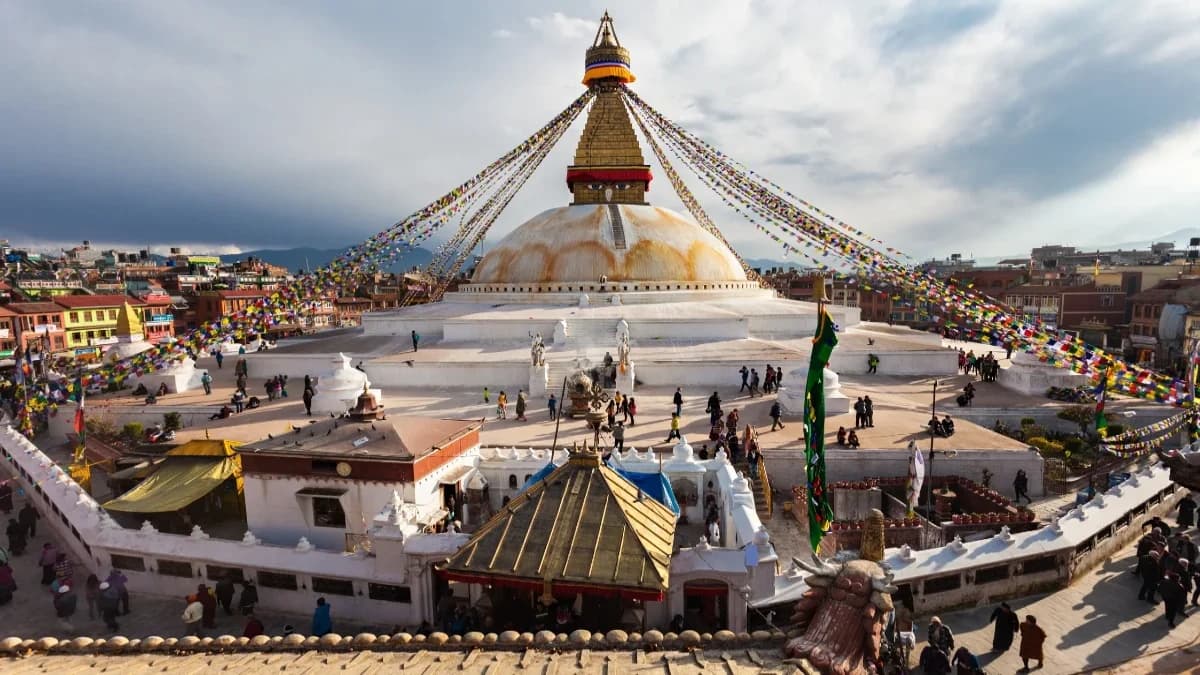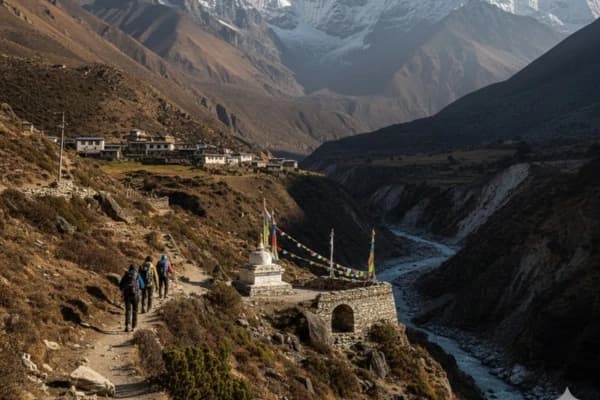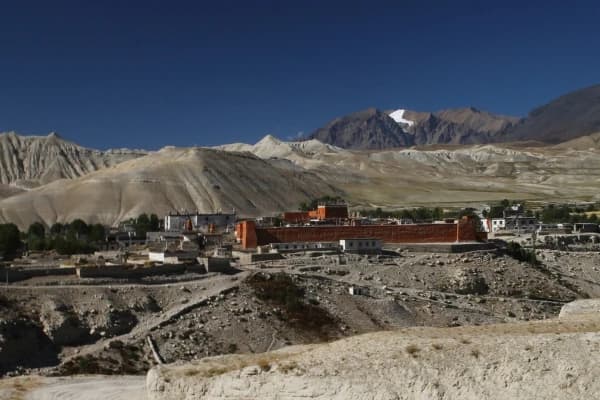Where is Kathmandu? Kathmandu is the capital city of Nepal and it is in the Kathmandu Valley, a central Nepal. The Kathmandu city is about 1,300 meters above sea level and is surrounded by hills like Shivapuri, Phulchowki, Nagarjun, and Chandragiri. These hills have protected the valley for a long time and have helped shape the culture of Kathmandu and its natural beauty.
Kathmandu has a long history dating back thousands of years, and several of its landmarks are recognized as UNESCO World Heritage Sites, including Kathmandu Durbar Square, Swayambhunath, and Boudhanath Stupa, with the first listing made in 1979. The city experiences a subtropical highland climate, with temperatures ranging from around 2°C in winter to 25°C in spring and autumn, making it ideal for sightseeing most of the year.
Visiting Kathmandu gives travelers a chance to explore its history, hills, and temples, giving a clear answer to where is Kathmandu? for travelers.
Join Nepal Gateway Trekking to explore temples, Durbar Squares, and the scenic hills before the next festival season fills up.
Quick Facts About Kathmandu
Kathmandu is the capital of Nepal and the biggest city in the Kathmandu Valley. These facts give a quick look at its location, population, and other aspects in Kathmandu, which helps travelers and students understand the city quickly.
|
Fact |
Detail |
|
Country |
Nepal |
|
Capital |
Yes |
|
Province |
Bagmati |
|
District |
Kathmandu |
|
Elevation |
1,300 m |
|
Population |
862,400 (city), 3 million+ (valley) |
|
Language |
Nepali + local language |
|
Major Rivers |
Bagmati |
|
Currency |
Nepalese Rupee |
|
Time Zone |
NPT (UTC+5:45) |
Geographical Location of Kathmandu
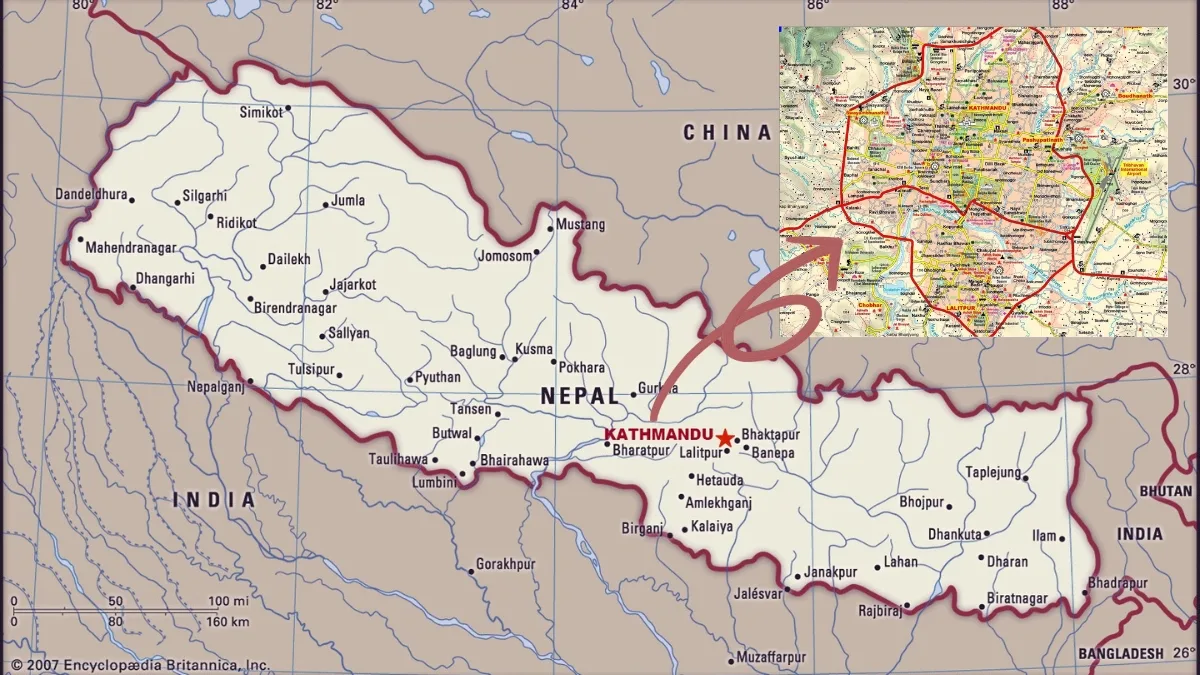
Shivapuri, Phulchowki, Nagarjun, and Chandragiri are among the hills that wrap around Kathmandu, which is located in the Kathmandu Valley in the middle of Nepal. Its central location and rich valley have allowed people to live here for thousands of years. The city's architecture and culture have been influenced by the surrounding Bagmati River.
The city is also strategically positioned near India to the south and Tibet to the north, making it an important hub for trade, culture, and history. This geographic setting influences Kathmandu’s climate, topography, and overall way of life, which we explore in the following sections.
Kathmandu on the Map
Kathmandu is located in central Nepal at a latitude of 27.7103° N and a longitude of 85.3222° E. Its position in the Kathmandu Valley places it amid several hills, which have shaped the city’s layout and provided natural protection throughout history.
The city is well-connected regionally, lying south of the Tibetan Plateau and north of the Indian plains. This central location has made Kathmandu a key hub for trade, culture, and travel within Nepal and beyond. Viewing a map of Kathmandu helps travelers understand how the city is positioned relative to rivers, hills, and nearby major cities.
Kathmandu Valley Overview
The Kathmandu Valley is the center of culture and geography in Nepal, and it includes three main districts: Kathmandu, Bhaktapur, and Lalitpur. The valley is about 25 km wide from east to west and 19 km long from north to south.
The valley has a flat, fertile land surrounded by hills that protect it. Its natural shape has allowed people to live there for thousands of years and has made it an important place for farming, trade, and the culture of Kathmandu.
Elevation and Climate
Kathmandu sits at an elevation of approximately 1,400 meters (4,600 feet) above sea level, which gives the city a mild and pleasant climate compared to the lower-lying areas of Nepal. This elevation influences both the daily life of residents and the experience of visitors, affecting temperature, rainfall, and vegetation throughout the year.
The city has a subtropical highland climate. Summers are warm with some rain, winters are cool and dry, and spring and autumn have mild temperatures. This climate supports agriculture in the valley, shapes the greenery of the surrounding hills, and makes Kathmandu accessible for tourists year-round.
Best Time to Visit Kathmandu
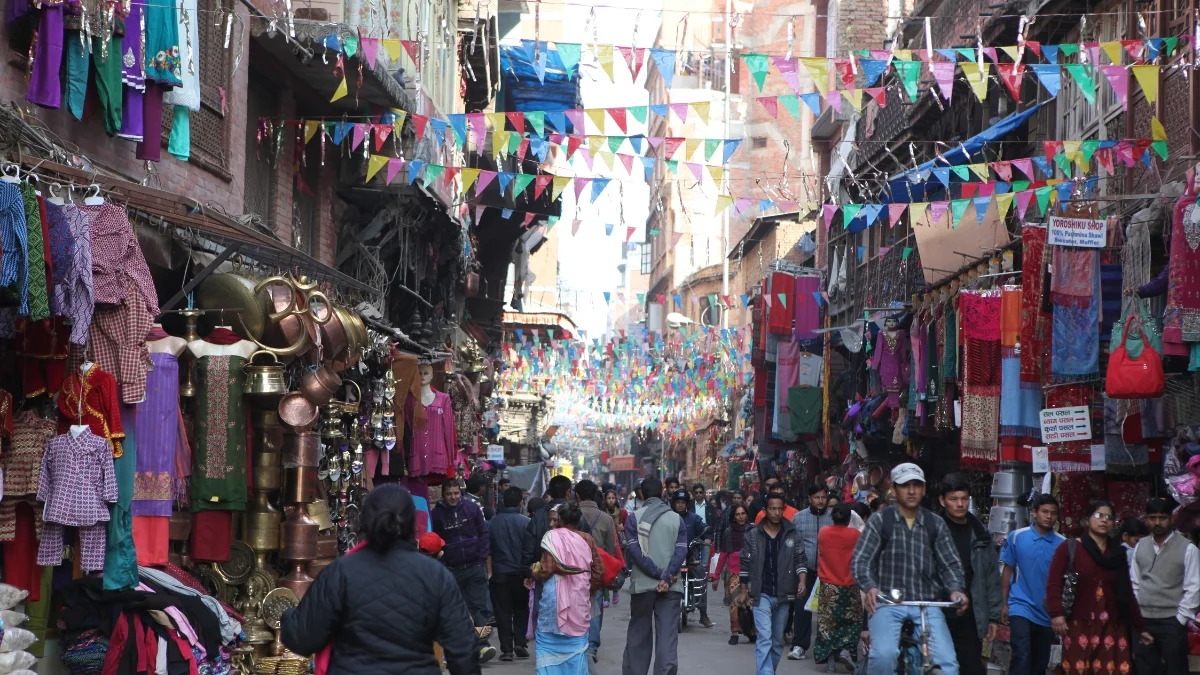
Spring and autumn are the best times to visit Kathmandu. These two seasons are ideal for trekking and sightseeing. Even winter brings clear skies and the chance for budget-friendly travel, making Kathmandu accessible all year round.
|
Season |
Weather |
Activities |
Festivals |
|
Spring (Mar-May) |
12-27°C, mild |
Sightseeing, trekking |
Holi |
|
Summer (Jun–Aug) |
18-28°C, warm |
Green landscapes, fewer tourists |
Rato Machhindranath Jatra |
|
Autumn (Sep–Nov) |
13-25°C, clear |
Trekking, photography |
Dashain, Indra Jatra |
|
Winter (Dec–Feb) |
3-19°C, dry |
Budget travel, mountain views |
None |
Spring and autumn in Kathmandu are unforgettable - wander colorful streets, catch vibrant festivals, and see the city come alive. Join our Kathmandu Valley Day Tour if you are interested in exploring the ancient cities of the valley.
Kathmandu – The Capital of Nepal
Kathmandu is the political, cultural, and business center of Nepal. It has government offices, international missions, and big companies, and it is also home to busy markets, old neighborhoods, and schools and colleges.
This central role affects how the city is run and the everyday life of its diverse people, which we will look at in the next sections.
Administrative Significance
Kathmandu is the center of Nepal’s government and administration. The city has the Prime Minister’s office, ministries, and other important government offices, making it the main place for political decisions in the country.
Besides running the government, Kathmandu also helps drive Nepal’s economy through its markets, banks, and international companies. Its role in administration is connected to its culture of Kathmandu and social influence, since the city shapes rules, trade, and events that affect the whole country.
Population and Demographics
Kathmandu has about 862,400 people living in the city, and more than 3 million people in the whole valley. The city has many different communities living together, speaking Nepali and other local languages.
This mix of people shapes Kathmandu’s culture, festivals, and daily life, making the city lively for both locals and visitors. Knowing about the population and who lives there helps travelers understand the social and cultural side of Nepal’s capital.
A City With Ancient History: Kathmandu
Kathmandu has been lived in for thousands of years and is one of the oldest cities in South Asia. Its long history shows in old temples, palaces, and monuments that tell the story of how the city changed under different rulers and cultures.
Ancient and Medieval History
People have lived in the Kathmandu Valley for thousands of years, going back to the 3rd century BCE. The city grew under different rulers, like the Licchavi (4th - 9th century CE) and Malla (12th - 18th century CE), and each left their mark on its buildings, temples, and the way the city is laid out.
During the medieval period, Kathmandu became a main place for trade between India and Tibet. Many palaces, shrines, and public squares built back then, like Kathmandu Durbar Square, Taleju Temple, and Kumari Ghar, are still standing today, showing the city’s history and architecture.
Kathmandu Through the Centuries
Over the centuries, Kathmandu has evolved from a small valley settlement into the capital of Nepal. In 1768, it became the political center when King Prithvi Narayan Shah unified the Kathmandu Valley under the Gorkha Kingdom.
The city has several UNESCO World Heritage Sites, like Kathmandu Durbar Square, Swayambhunath Stupa, and Boudhanath Stupa, which were added in 1979. Kathmandu has also been through big events like the 1934 and 2015 earthquakes, which changed parts of the city but kept much of its historic buildings safe.
Culture, Arts, and Architecture of Kathmandu
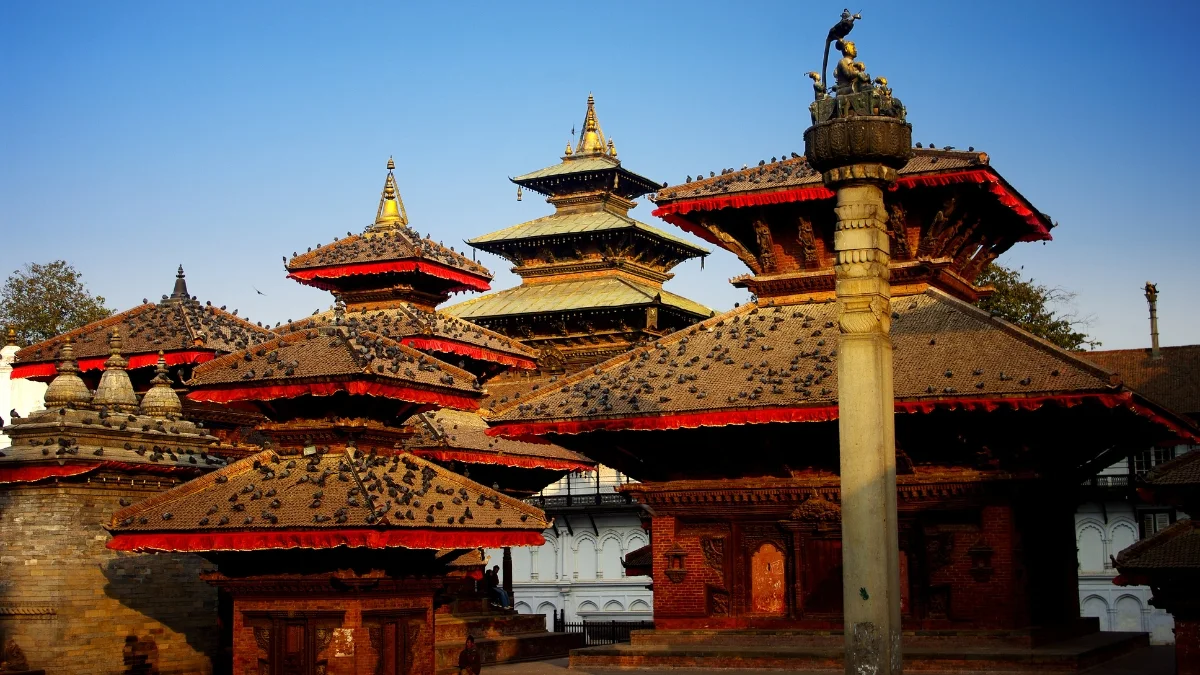
Kathmandu is a city where history and everyday life come together through lively traditions, art, and buildings. Visitors can see the culture of Kathmandu in its temples, palaces, music, dance, and local crafts.
Famous Temples and Religious Sites
Kathmandu has many important temples and religious places that show both Hindu and Buddhist traditions. These holy sites attract pilgrims from all over Nepal and other countries, and they are also important landmarks for the culture of Kathmandu.
Some of the most notable sites in the city include:
- Pashupatinath Temple is one of the most important Hindu temples in Nepal, dedicated to Lord Shiva.
- Swayambhunath (Monkey Temple) is a famous Buddhist stupa that gives great views of the city.
- Boudhanath Stupa is a main place for Tibetan Buddhism, known for its big white dome and prayer wheels.
- Guhyeshwari Temple, a holy Hindu site near Pashupatinath Temple, is known for different rituals and festivals in Kathmandu.
Durbar Squares and Palaces
Kathmandu’s Durbar Squares are historic city centers that showcase the artistry, architecture, and cultural life of the city. These areas were once royal palaces and administrative hubs, and today they remain vibrant spaces where locals and tourists gather.
In Kathmandu, the main Durbar Square has landmarks like Taleju Temple, Kumari Temple, Jagannath Temple, Nasal Chowk, Swet Bhairav, Shisha Baithak, and the Tribhuvan Museum. Walking around these squares lets visitors feel the city’s history, traditional crafts, and amazing buildings, which have shaped the culture of Kathmandu over hundreds of years.
Arts, Festivals, and Local Lifestyle
Kathmandu’s culture comes alive through its festivals, music, dance, and traditional crafts. Major festivals in Kathmandu, such as Dashain, Indra Jatra, and Tihar, attract locals and tourists alike. You can visit during a specific time for these elaborate rituals, processions, and community gatherings.
Local arts include wood carving, pottery, painting, and textile work, visible in temples, homes, and markets. Daily life reflects the culture of Kathmandu, blending traditional customs with modern influences. To experience the lifestyle here, you can visit the bustling markets and street food, cultural performances, and the lively neighborhoods of Thamel in Kathmandu.
Discover the culture of Kathmandu with Nepal Gateway Trekking and uncover hidden temples, local markets, and secret spots only locals know.
Travel and Tourism in Kathmandu
When visiting Nepal, the majority of visitors arrive in Kathmandu. There is a variety of history, culture, and nature to discover. Are you aware of Kathmandu's location? helps tourists decide which sites to see first and how to get there.
Tourism in Kathmandu includes visiting old temples and palaces, checking out nearby hills and nature spots, exploring local markets, and taking part in festivals. The city also connects travelers to other parts of Nepal, like Pokhara and Chitwan. Most importantly, Kathmandu is where many people start their trek to Everest Base Camp, making it an important stop for visitors.
How to Reach Kathmandu?
Kathmandu is well-connected both internationally and within Nepal, so travelers from around the world can reach it easily. Tribhuvan International Airport is the main entry point for international flights from countries like India, the USA, and Australia.
- Fly to Tribhuvan International Airport (KTM) from major countries.
- Take domestic flights or taxis to Kathmandu city center.
- For India/Nepal border crossings, use road transport via Sunauli or Raxaul.
Day Tours and Nearby Attractions
Kathmandu offers many short trips and day tours where visitors can explore cultural landmarks and natural beauty while experiencing the culture of Kathmandu.
Bhaktapur and Patan Durbar Squares of valley, the Chandragiri Hills for trekking and mountaineering, and the routes to Everest Base Camp for adventurers are all well-liked destinations. In order to provide tourists a close-up look at the local festivities, many trips are scheduled around Kathmandu's festivals.
Go on a Kathmandu Day Tour today with Nepal Gateway Trekking and check out the city’s temples, Durbar Square, and surrounding hills.
Things to Do in Kathmandu
Explore the city and its surroundings with these activities:
- Visit historic temples and palaces to see the culture of Kathmandu
- Explore Bhaktapur and Patan Durbar Squares for architectural buildings and local crafts
- Hike the Chandragiri Hills for great views and trekking destination
- Take guided tours that connect to Everest Base Camp and more
- Shop for traditional handicrafts and souvenirs
- Join festivals in Kathmandu to experience the lively culture
- Take part in wellness or spiritual retreats
For trek lovers, we have Kathmandu Valley Rim Trek- 5 Days which covers the beautiful places of valley. Hurry up!
Final Thoughts
Where is Kathmandu? Situated in the Kathmandu Valley, encircled by hills and the Bagmati River, it serves as the capital of Nepal. The city is a popular tourist destination because of its rich history, temples, palaces, and Kathmandu culture.
From visiting historic sites to joining festivals in Kathmandu or hiking nearby hills, there is something for everyone. Plan your trip to enjoy the city’s heritage, lively lifestyle, and natural beauty, and find out why Kathmandu is the heart of Nepal.
Get your adventure started today! Explore, tour, and enjoy the festivals in Kathmandu – don’t wait too long. Reach out to Nepal Gateway Trekking Now!
Frequently Asked Questions
Where is Kathmandu located?
Kathmandu is the capital city of Nepal, located in the central Kathmandu Valley. It is surrounded by hills and sits along the Bagmati River, making it a beautiful and historic city.
Is Kathmandu the capital of Nepal?
Yes, Kathmandu is Nepal’s political, cultural, and economic center, hosting government offices, embassies, and financial institutions.
What is the elevation of Kathmandu?
The city sits at approximately 1,400 meters (4,593 feet) above sea level, which gives it a mild subtropical highland climate.
What is the population of Kathmandu city and valley?
Kathmandu city has around 862,400 residents, while the wider valley has about 3 million people, representing diverse ethnic and linguistic communities.
Which rivers flow through Kathmandu?
The main river is the Bagmati River, which is considered sacred and is very important for the religion and culture of Kathmandu.
What is the best time to visit Kathmandu?
Spring (March-May) and autumn (Sep-Nov) are the best times, offering clear skies, pleasant temperatures, and opportunities to enjoy festivals in Kathmandu.
How can I reach Kathmandu from India, the USA, or Australia?
Fly to Tribhuvan International Airport (KTM) from major countries. Domestic flights, taxis, or road connections via India (Sunauli or Raxaul) are convenient options to reach the city center.
What are the main attractions in Kathmandu?
Visitors can explore temples, palaces, Durbar Squares, and nearby hills for trekking, as well as enjoy local markets, traditional crafts, and cultural tours.
What are the major festivals celebrated in Kathmandu?
Major celebrations include Dashain, Indra Jatra, and Tihar, which show the festivals in Kathmandu, its lively traditions, rituals, and community life.
Is Kathmandu safe for tourists?
Yes, Kathmandu is usually safe for tourists, but it’s important to follow normal travel precautions, especially in crowded places and during big festivals in Kathmandu.
